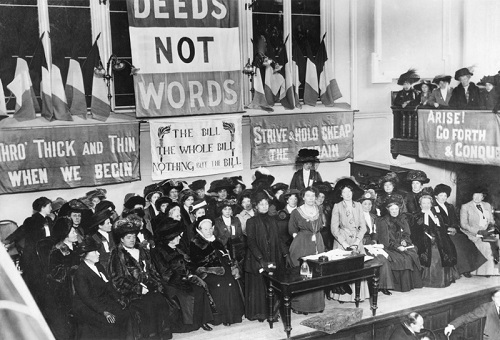Women in the UK received the right to vote for the first time 100 years ago today: February 6, 1918. Numerous cities are celebrating the centenary today and throughout the season. Here are the facts you need to know:
- The “Representation of the People Act” proposed the right for British women to vote – but only if they were over the age of 30, a property or homeowner, and a member of or married to a member of the Local Government Register, or were a university graduate voting in a university constituency. The bill also reformed male voting by removing most property qualifications for men over 21, and allowed men to vote as young as age 19 if they served in the armed forces. It received royal assent on February 6, 1918.
- Women could already vote in nations including Finland, Norway, Denmark, and Australia.
- British women would receive the same voting rights as men in 1928.
- Like the U.S. civil rights movement, many of the suffragettes cited spiritual reasons for their activism. Helena Swanwick wrote, “[L]et there be no mistake about it – this movement was not primarily political; it was social, moral, psychological, and profoundly religious.” British suffragettes often used Joan of Arc as a symbol.
- Since the Church of England did not embrace the right of women’s suffrage, more militant leaders planted bombs inside Westminster Abbey, St. Paul’s Cathedral, Rosslyn Chapel, and other Anglican churches. One of these damaged the Coronation Chair and the Stone of Destiny in 1914. Other targets included the Bank of England, the National Gallery, and numerous train stations. However, Women’s Social and Political Union leader Emmeline Pankhurst reportedly gave orders that “not a cat or a canary to be killed: no life.”
- The Archbishop of Canterbury, Randall Davidson, had privately supported women’s suffrage – but refused to take a stance publicly, for fear of rewarding the suffragettes’ vandalism. He feared the militants would ask if “‘they have even converted a stolid Archbishop?’ whereas in the first place he was fairly converted before.” The Home Secretary, Winston Churchill, likewise assessed that, by the militant suffragettes’ actions, “their cause has marched backwards.”
- The United States would not allow women to vote until the adoption of the Nineteenth Amendment to the Constitution on August 26, 1920. However, women could already vote in 15 states.
- The first female monarch since the passage of the act, Queen Elizabeth II, became queen on February 6, 1952, upon the death of her father, King George VI. Every February 6 is commemorated as “Accession Day,” as well as remembering the date that women first won the right to vote.
- The number of female MPs in Parliament hit an all-time high after the June 2017 snap election: 208 of 650 members of the House of Commons are women (119 Labour, 67 Conservative, 12 SNP, and four Liberal Democrats).
- There have been two female prime ministers of the UK: Margaret Thatcher and Theresa May, both Conservatives.
(Photo credit: Public domain.)

